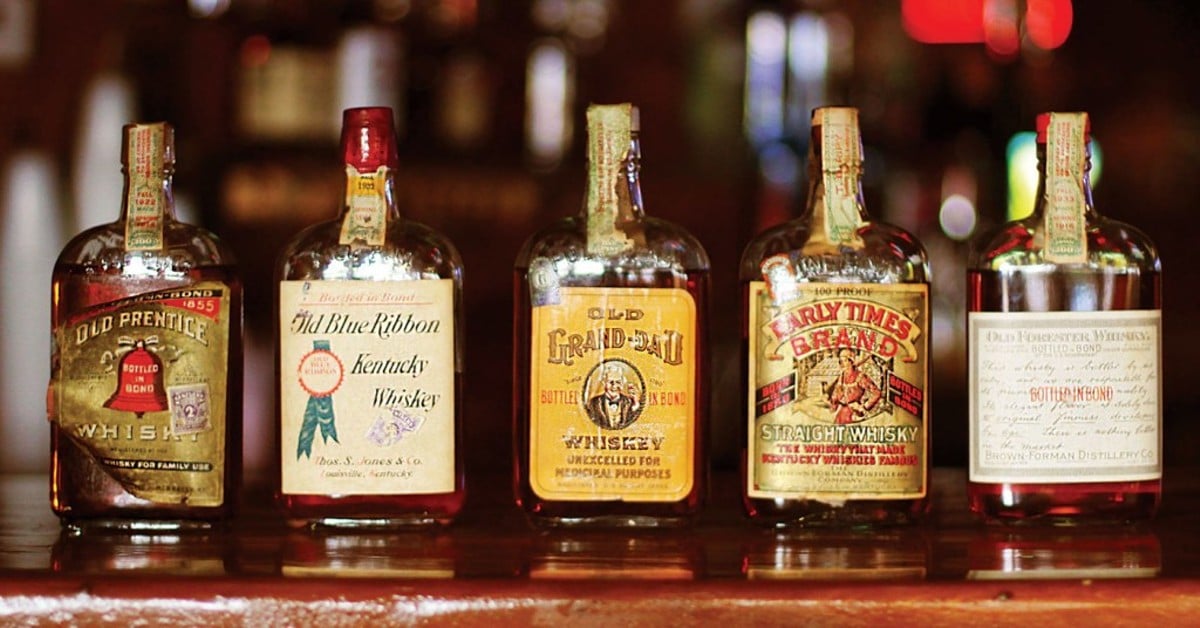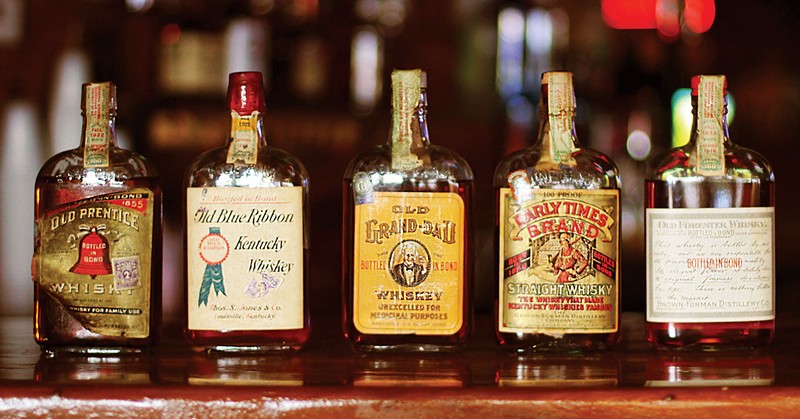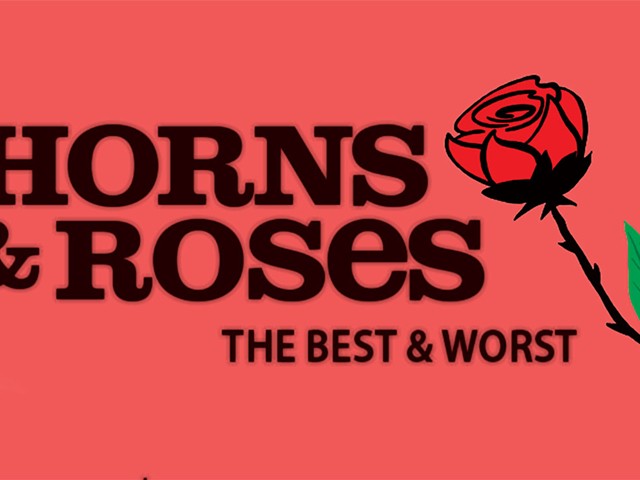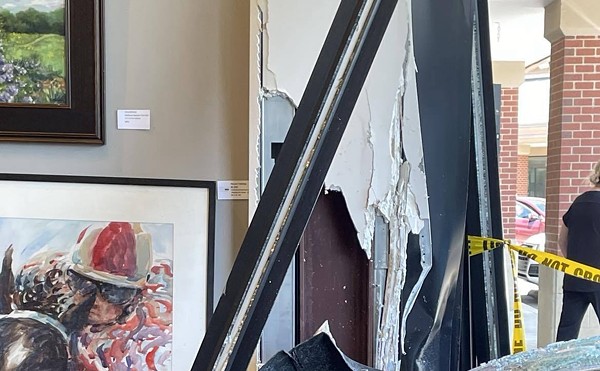The year 1897 was especially important in the annals of bourbon history. Distiller Edmund Taylor, aka Col. E.H. Taylor, Jr., had become concerned about unscrupulous practices of some whiskey wholesalers (known as rectifiers), who diluted the products they bought by the barrel from distillers and then bottled. Among other egregious practices, the rectifiers added illegal flavorings (including tea and prune juice), and even lied about bottle contents on their labels. Eager to protect the reputation of his brand in particular, and bourbon whiskey in general, Taylor convinced Kentucky’s U.S. Sen. Joseph Blackburn to work for the passage of the Bottled-in-Bond Act.
In effect, this was the first American consumer protection law, because the U.S. government would now guarantee the quality of the bourbon in the bottle. In order to earn the B-I-B designation, a whiskey had to be made at a single distillery by a single distiller in a single season, had to be aged at least four years in a federally-bonded warehouse and had to be bottled at 100 proof. The label also had to state the distillery name. Bonded whiskies were sealed with a green stamp, sporting an engraved image of treasury secretary, and former Kentucky congressman, John Carlisle.
But not all whiskies have to be bonded.
Of the hundreds of bourbons found on the market today, fewer than 20 conform to the 1897 law. One example is Henry McKenna, bearing a label almost encyclopedic with information. It has an age statement (10 years). “Bottled-in-bond” is prominently printed. The alcohol content (50 percent, 100 proof) is easy to find on the label. It also happens to be a single barrel bourbon, and the barrel number and the date the whiskey was put into that barrel are handwritten on the front label. The back label states that Henry McKenna was “distilled and bottled” by Heaven Hill Distillery, Louisville, KY (D.S.P. KY-1) and Bardstown, KY (D.S.P. KY-31).
D.S.P. is Distilled Spirit Plant, and every licensed distillery is assigned a D.S.P. number. In this case, the bourbon is made at Heaven Hill’s distillery in Louisville (KY-1) and bottled at the company’s facility in Bardstown (KY-31), the designation of the Heaven Hill’s distillery destroyed by fire in 1996.
But in the case of non-bonded bourbons, such information, which is often of interest to consumers, has been disappearing, even as the popularity of brown spirits, along with the number of bourbons on store shelves, has been increasing.
“My personal rule of thumb is that the more information you provide about your product, the more pride you have in it. Every time an age statement is dropped, or a whiskey’s origin is obscured, an angel dies,” is the opinion of Reid Mitenbuler, New York-based whiskey writer and author of “Bourbon Empire: The Past and Future of America’s Whiskey.”
In order for a whiskey to be called bourbon, at least 51 percent of the grain in the recipe (mash bill) to be cooked and fermented must be corn. The rest is usually rye and malted barley. In a few bourbons, wheat is substituted for rye. These are known as wheated bourbons. The resulting distillate must be aged in “new charred oak containers.” It cannot be put in the container (usually a 53-gallon barrel) at higher than 125 proof, and it cannot be bottled at less than 80 proof. Nothing may be added to bourbon (no flavoring or coloring, for example), except distilled water to adjust the proof.
Age-less labels
Age statements are required on bourbon labels only if the whiskey is aged less than four years. A bourbon is identified as “straight” if it is aged at least two years. A check of labels of many popular brands reveals that very often the distilleries bottling straight bourbons less than 10 years old, and aged at least four years, simply omit the age statement. Examples include Woodford Reserve, Four Roses Small Batch, Buffalo Trace and Jim Beam White Label. Though Jim Beam Black Label is “Double Aged 8 Years.” (Does that mean that the White Label, the best selling bourbon in the world, by the way, is four years old?)Conversely, if bourbon has been aged for a number of years in double digits, distillers usually want you to know. Evaporation during aging (about 4 percent per year, known as the angels’ share) decreases the volume of whiskey in the barrel available for bottling. Since there is less product — sometimes much less — at the end of many years of aging, older bourbons tend to be more expensive.
The demand for some brands has meant that some distillers may age for less time than they used to, in order to get their whiskey on the shelves. For example, until this year the very popular Basil Hayden’s, made by Beam Suntory, carried an eight-year age statement. But the bottle labels on store shelves now simply read “Artfully Aged.”
Carla Carlton of Louisville, who reports on the bourbon industry as The Bourbon Babe (thebourbonbabe.com) has noted the supply-and-demand dilemma for aged products, too.
“I was sad to see the Elijah Craig 12 disappear, but I understand what’s happening. With the increased demand for bourbon, distillers just don’t have the inventory they once had and can’t afford to let as many barrels get that old. I hope that at some point they’ll catch back up! Mostly, I want bourbon labels to be honest and true. I don’t care if a bourbon is sourced from MGP [Midwest Grain Producers, a former Seagram’s facility in Lawrenceburg, Indiana, that is a large contract distiller] and blended, as long as the label says that, and doesn’t claim some origin story dating back to good ol’ great Grandpa Willie.”
Listless enforcement
The rules for labeling are the responsibility of the Alcohol and Tobacco Tax and Trade Bureau (TTB), the federal agency that must approve labels for all alcoholic beverages made in the United States. Given the large number of new products coming onto the market (craft beers and wine, as well as spirits), the rules that do exist for labeling are not always enforced, or the regulators simply don’t catch mistakes.Louisville-based spirits writer Fred Minnick, author of “Whiskey Women: The Untold Story of How Women Saved Bourbon, Scotch, and Irish Whiskey,” “Bourbon Curious: A Simple Tasting Guide for the Savvy Drinker” and the forthcoming “Bourbon: The Rise, Fall, and Rebirth of an American Whiskey,” said that federal enforcers “… do what they can with the budget Congress approves, but there are so many awful labels approved in all spirits. I seem to recall a bottled-in-bond flavored whiskey that slipped through the cracks, and a sugar beet rum, which by law is supposed to come from a sugar cane base.”
Minnick thinks that the major distillers know that it is in their best self-interest to follow the rules. “After Prohibition, until 1982, the government made distillers back up their label and advertising claims, and distilling industry widely favored these regulations. They eventually testified in favor of more government. When have you heard of an industry asking for more regulation? The reason why is they never wanted to see another Prohibition. The industry does a good job policing itself, but we need a claim verification system to decrease consumer deception attempts.”
Steve Ury of Los Angeles writes a blog called “SKU’s Recent Eats” (recenteats.blogspot.com), which contains several useful links to bourbon-related information, including the invaluable “Complete List of American Whiskey Distilleries and Brands,” he updates regularly. His take:
“In terms of information that is legally required but often missing, the two big ones are age and state of distillation. Under the federal regulations, any whiskey under 4 years old is supposed to have an age statement, but I regularly see young whiskeys that do not have one or that have a maximum age statement (e.g. ‘less than 2 years old’), which is not permissible under the regulations. Whiskeys that are distilled in a different state from where the producer is located are supposed to list the state of distillation, and that information is also often missing. These are both important pieces of information in terms of informing the consumer of the contents of the whiskey.”
Any whiskey less than 2 years old should carry an exact age statement, such as 18 months, according to regulations.
He said he also would like whiskey companies to list on labels when they use additives, such as caramel, sugar, etc., although that is not legally required. “While bourbon and straight whiskeys cannot contain additives, other non-straight whiskeys, such as rye, can, and I’d like to know what I’m drinking, just like I want to see the ingredients for the food that I buy. The whiskey geek in me also loves to see mash bills ... the more information the better.”
The Kentucky Distillers Association gives out the impressive statistic that 95 percent of the world’s bourbon is made in Kentucky. Contrary to what many people think, bourbon does not have to be made in Kentucky, but it does have to be made in America. An act of Congress in 1964 declared bourbon “America’s Native Spirit.”
Interestingly, while made here, it’s not always bottled here.
Rectifier heirs?
One of the reasons there are so many brands of bourbon is that scores of craft distillers across the country have started making bourbon. (The American Distilling Institute defines a craft distillery as producing less than 100,000 proof gallons annually. By comparison, Wild Turkey has the capacity to make 11 million proof gallons per year.) But in addition to the increase in the number of small craft distillers, there are also a lot of companies — which might be thought of as the heirs of the rectifiers — that buy their bourbon from big distilleries, bottle it and put their own labels on it.These are referred to in the whiskey world as NDPs, Non Distiller Producers. There is certainly nothing illegal about this. In fact, there are many excellent “sourced” or “contract distilled” bourbons on the market. Jefferson’s Reserve is one. For many years, Bulleit bourbon was made under contract at Four Roses. (Labels on older bottles of Bulleit state Lawrenceburg, Kentucky, as the place where it was made.) But NDPs do not have to say exactly from which distillery their bourbon comes, and many have non-disclosure agreements with their sources.
Charles Goodnight bourbon is named after a famous 19th-century cowboy and Texas Ranger. Its label states that it is “leather tough and velvet smooth.” It is also identified as 100-proof, Kentucky straight (therefore supposedly produced in Kentucky), and small batch. There is no age statement (though the company website says it is “a blend of six-year-old bourbons”). Read the fine print and “Bottled by Goodnight Distillery, Parlier, California” indicates that this bourbon was sourced. “Distillery” should not be taken literally, either. It is simply the name of the company, not an actual working distillery.
‘Foraged afield’
A notably-vague label was recently submitted to the TTB for a bourbon called Fiddler. There is, as required, a proof statement (86), and the back label says that it is “high wheat,” so there is wheat in the mash bill. But, there is no indication if this is in addition to, or instead of, rye. “Information” that should raise eyebrows is also printed on the back label: “Foraged afield, then finished and bottled by ASW Distillery at 199 Armour Drive, Suite C, Atlanta, Georgia 30324, a stone’s throw from the Georgia Capitol.”“Foraged” of course, means sourced. And “afield” pretty much covers all 50 states. Where was this whiskey made?
Fiddler is a pretty extreme example. On the other hand, Steve Ury could cite both NDPs and a craft distiller who are much more forthcoming with information.
“Most of the big distilleries are pretty good at complying with the regulations. Of the companies that use sourced whiskey, High West [Park City, Utah] does a particularly good job with the labels. They are always clear that their whiskey is sourced and usually disclose where it is from and how old it is. Smooth Ambler [Maxwelton, West Virginia] also does this well. Tom’s Foolery [a craft distillery], in Ohio, has an amazing website that lists every single barrel in their rackhouse along with the proof and fill level. In terms of transparency, it goes beyond anything I’ve seen and is really a model for the industry.”
Ask an expert
Of course, all this can be pretty confusing to the average bourbon drinker. So it is a good idea to find a knowledgeable liquor store proprietor who can help guide you through the labyrinth of label lore.Chris Zaborowski is co-owner of Westport Whiskey & Wine in Westport Village and a certified Executive Bourbon Steward. He thinks there are several ways labels could convey better information to bourbon drinkers.
“At one point it was common to see the DSP number on the labels, it will add some authenticity to the products … addition or clarification of items like distillery locations [would be good]. Maybe have the production statement better defined as they do wine. What is commonly accepted is where it was made and bottled. Nebulous terms used in wine like, ‘cellared and bottled by,’ ‘aged and bottled by,’ do not convey an actual production and could be applied to whiskey, too. ‘Made and bottled by’ implies a certain level of production, which could be amended to ‘batched and bottled by’ for bourbon/rye. And ‘distilled and bottled by’ would be that true ‘estate’ product.”
Zaborowski said he would like to see the state of Kentucky adopt a “standard of identity.”
“We need to get ahead of the curve and make the claim the bourbon produced in Kentucky is authentic. Bourbon is not only the U.S. Native Spirit, but it is nascent to Kentucky. It could be a seal that is added to bottles produced here, an implied quality seal, but a stamp of authenticity.”
Lew Bryson, former managing editor of Whiskey Advocate magazine and author of several books on whiskey and beer agreed that it would be good to have “the actual address of where the bourbon was distilled.” But he’s not necessarily in favor of “full disclosure.”
“I think there is a certain amount of overwrought hand-wringing about knowing everything about a whiskey. I really only need to know three things: who made it, how much does it cost, and whether I like it. Everything else is gravy. It may help in figuring out whether I’m going to like another whiskey, but as always, the best way to know that is to taste it. Do the work.” •
Reigler is the author of books including “Kentucky Bourbon Country: The Essential Travel Guide,” and is co-author of “The Bourbon Tasting Notebook” and “The Kentucky Bourbon Cocktail Book.”







